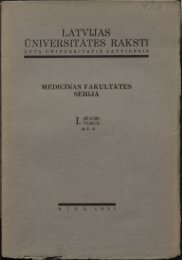UMIVERSITATIS LATVIENSIS - DSpace
UMIVERSITATIS LATVIENSIS - DSpace
UMIVERSITATIS LATVIENSIS - DSpace
Erfolgreiche ePaper selbst erstellen
Machen Sie aus Ihren PDF Publikationen ein blätterbares Flipbook mit unserer einzigartigen Google optimierten e-Paper Software.
crispa,<br />
Ulota lutea varies considerably, perhaps not less than U.<br />
in the leaf form, the size and the form of the capsule,<br />
and in the height and structure of the peristome. I shall con-<br />
fine myself to the description of the variation in the respective<br />
organs, without naming the various forms. I do this because<br />
the quantity and condition of the material investigated seems<br />
to be insufficient to give<br />
and forms within the species.<br />
types.<br />
a detailed classification of varieties<br />
As to the leaf form there can be traced at least two<br />
The first is found in the Tasmanian and also in the<br />
Australian plant, so far as I know the latter. The leaves of<br />
the Australian type (Fig. 2, a) are rather long with a more elong-<br />
ated base than in the other type. This type<br />
met with in the New Zealand plant, has usually<br />
with a broader, elegantly<br />
which is to be<br />
shorter leaves<br />
outlined obovate base. The leaves<br />
are greatly narrowed at the insertion, rather rapidly<br />
dilated to<br />
the top of the base and suddenly contracted above it. (Fig. 2,<br />
b, c.) In Bell's collections from the South Island there could<br />
be found plants with a very broad, somewhat rounded, base<br />
of the leaf (Fig. 2, d) this leaf form being a subtype of the<br />
New Zealand type. The length of the seta does not vary much.<br />
As to the variation of the size of the capsule, relatively short<br />
capsules were met with in plants<br />
from the South Island of New<br />
Zealand. Some Tasmanian plants show irregularities in the peri-<br />
stome, the endostome being irregular in its basilar part and<br />
in this respect resembling the praeperistome<br />
of some Orthotri-<br />
chum species (Fig. 3, d). In the endostome 8 processes alternating<br />
with the teeth are always present,<br />
ments of processes standing behind the teeth,<br />
but often there can be seen rudi-<br />
some of these<br />
processes being sometimes well developed. On the inner side<br />
of the exostome the transverse bars reach down to the middle<br />
in the New Zealand plant, while in the Tasmanian they<br />
fined to the top of the teeth (Fig. 3, c, d). Although<br />
are con-<br />
there are<br />
differences in the leaf form and in the structure of peristome<br />
between the Australian and New Zealand plants, they are very<br />
slight and I have hesitated in naming<br />
these forms as varieties<br />
or subspecies and have considered them only geographical races.<br />
The var. robusta may seem a luxuriant form only,<br />
but as<br />
the plant has small capsules with a short peristome it may prove<br />
afterwards that it deserves a higher rank than a forma.<br />
U Weymouthii from Falls Track,<br />
(Weymouth, n. 615)<br />
7<br />
Mt. Wellington<br />
bears various author names as "Burchard"<br />
in Weymouth (1893), "C. Müll." in W a t t s & White-<br />
legge (1905) and "Venturi" in Rod way (1914).<br />
sider the plant the Australian race of U lutea.<br />
I con


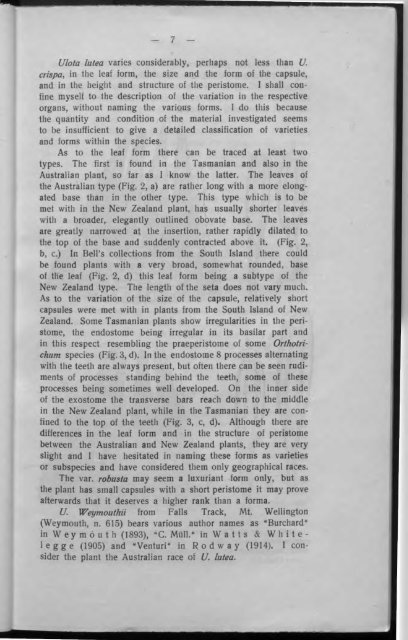
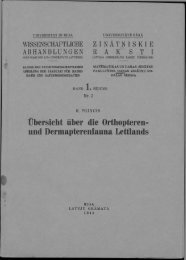
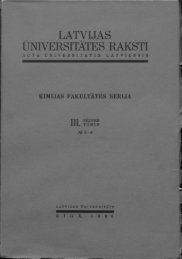
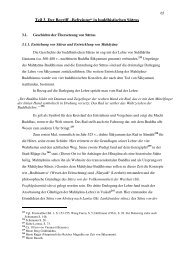
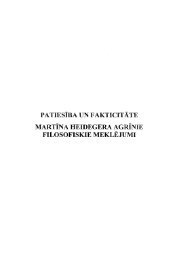
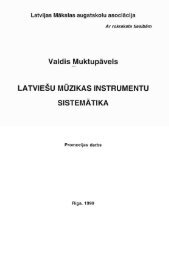
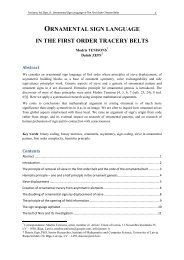
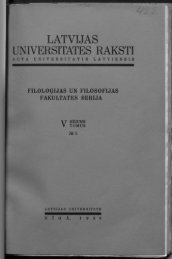
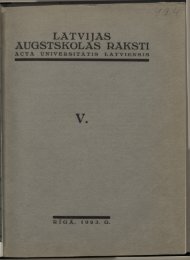


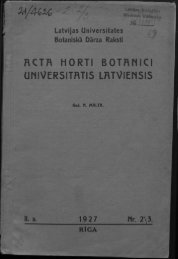
![LATVIJAS] - DSpace](https://img.yumpu.com/11778577/1/190x249/latvijas-dspace.jpg?quality=85)
